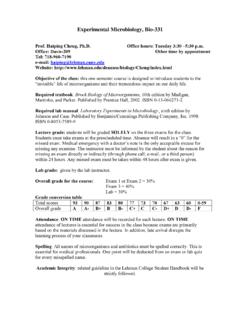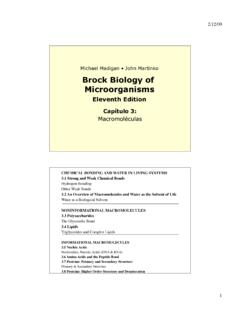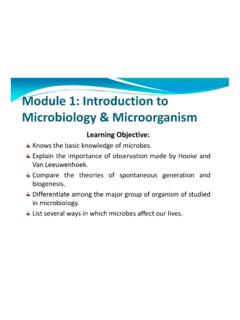Transcription of Monday Oct 16 - Ch 10 -Brock Genetic Exchange in …
1 Systems Microbiology Monday Oct 16 - Ch 10 - brock Genetic Exchange in bacteria Homologous recombinationHomologous recombination TransformationTransformation Plasmids and conjugationPlasmids and conjugation Transposable elementsTransposable elements Transduction (virus mediatedTransduction (virus mediated xchangexchange) ) Gene Exchange in bacteria Transfer of DNA from one bacterium to another is a common means of gene dispersal. It has a big effect on bacterial evolution, and tremendous practical implications. For example, lateral transfer is responsible for the spread drug resistance determinants between bacterial species. Three common mechanisms of lateral gene Exchange : Transformation (extracellular DNA uptake) Conjugation (bacterial mating systems) Transduction (viral mediated gene Exchange ) RecA mediated Homologous recombination Images removed due to copyright restrictions.
2 See Figures 10-9 and 10-10 in Madigan, Michael, and John Martinko. brock biology of ed. Upper Saddle River, NJ: Pearson Prentice Hall, 2006. ISBN: 0131443291. Gene Exchange in bacteriaTransformation Discovered by Griffith in 1928 during the course of his studies of virulence in Streptococcus pneumoniae. S=smooth colony morphotype R=rough colony morphotype InjectionLive "smooth" (encapsulated)type 1 pneumococci (S1)Dead mouse; yields S1 cellsHeat-killed S1 Live mouseLive mouseLive "rough" (unencapsulated)pneumococci (R1 or R2) derived by subculture from S1 or S2, respectivelyLive R1 Live R2 Killed S1 Killed S2 Dead mouse; yields S1 cellsDead mouse; yields S1 cells++SDead SR1 + Dead SR2 + Dead SThe Griffith ExperimentFigure by MIT Exchange mechanisms in bacteriaTransformationAvery, MacLeod, and McCarthy (1944) fractionation studies led to conclusion that transformation principle is DNA.
3 InjectionLive "smooth" (encapsulated)type 1 pneumococci (S1)Dead mouse; yields S1 cellsHeat-killed S1 Live mouseLive mouseLive "rough" (unencapsulated)pneumococci (R1 or R2) derived by subculture from S1 or S2, respectivelyLive R1 Live R2 Killed S1 Killed S2 Dead mouse; yields S1 cellsDead mouse; yields S1 cells++SDead SR1 + Dead SR2 + Dead SThe Griffith ExperimentFigure by MIT Exchange mechanisms in bacteria Transformation (uptake of exogenous DNA) Physiological transformation occurs in nature in a wide variety of genera which include: Diagram showing the Genetic interconnections demonstrated between bacterial groups removed due to copyright restrictions. 1) Streptococcus 2) Staphylococcus 3) Bacillus 4) Acinetobacter 5) Hemophilus 6) Neisseria Natural Bacterial Transformation Image removed due to copyright restrictions. Closely Linked Genes will Tend to Transform Together More Frequently than More Distal Genes Gene Exchange mechanisms in bacteria Transformation Competence.
4 The ability to take up DNA varies regularly during the cell cycle. In Image removed due to copyright restrictions. Streptococcus competence is See Figure 10-14 in Madigan, Michael, and John Martinko. brock biology of highest shortly after cell ed. Upper Saddle River, NJ: Pearson Prentice Hall, 2006. ISBN: 0131443291. division. Entry & integration. Cell components required for uptake. Heteroduplex formation with homologous recipient DNA. Artificial TransformationDouble-stranded DNA forced through cytoplasmic membraneIntegration of linear fragments by homologous recombination or replication of plasmidFigure by MIT Conjugation -Image of bacterial conjugation, showing the donor (F+), pilus, and recipient (F-), removed due to copyright restrictions. PLASMIDS Extrachromosomal DNA, usually circular Usually encode ancillary functions for in vitro growth Can be essential for specific environments: virulence, antibiotics resistance, use of unusual nutrients, production of bacteriocins (colicins) Must be a replicon - self-replicating Genetic unit Plasmid Replication Plasmid DNA must replicate each time cell divides or it will be lost Host cells do not spit out plasmid DNA Two functions required in replication DNA replication Partitioning (distributing plasmid to progeny cells) High copy (>20) and low copy (<5) plasmids Plasmid Replication High copy plasmids are usually small; low copy plasmids can be large Partitioning is strictly controlled for low copy, but loose for high copy Plasmid replication requires host cell functions (DNA polymerase, etc.)
5 Copy number is regulated by initiation of plasmid replication Plasmids are incompatible when they cannot be stably maintained in the same cell because they interfere with each other s replication. Confers resistance : sulfonamide chloramphenicol mercury ions streptomycin tetracycline Image removed due to copyright restrictions. See Figure 10-20 in Madigan, Michael, and John Martinko. brock biology of Microorganisms. 11th ed. Upper Saddle River, NJ: Pearson Prentice Hall, 2006. ISBN: 0131443291. Table of some phenotypes conferred by plasmids in prokaryotes removed due to copyright restrictions. See Figure 10-3 in Madigan, Michael, and John Martinko. brock biology of Microorganisms. 11th ed. Upper Saddle River, NJ: Pearson Prentice Hall, 2006. ISBN: 0131443291. concatemers ROLLING-CIRCLE MODEL OF BACTERIOPHAGE DNA REPLICATION FOR THE SYNTHESIS OF DOUBLE-STRANDED DNA daughters ColEI plasmid small ( kb) medium copy #/cell (20 copies/cell) non-self-transmissible does not require de novo protein synthesis for replication (chloramphenicol amplifiable) RNA-II is transcribed through the origin of replication, gets cut by RNaseH and serves as the primer for DNA replication RNA-I is transcribed in the opposite orientation and is complementary to RNA-II.
6 Binding of RNA-II and RNA-I prevents initiation of replication (RNA-I is a negative regulator) the Rom/Rop protein made by the rom/rop gene stabilize the binding of RNA-I and RNA-II (also negative regulator) F plasmid large (100 kb) low copy #/cell (1-2 copies/cell) self transmissible (tra genes) requires protein synthesis (chloramphenicol-sensitive) repE gene encodes RepE protein RepE protein binds to origin of replication (oriS) and initiates DNA replication RepE binds to the repE promoter and activates transcription RepE binds to the copA/incC locus and is titrated away from oriS and repE (negative regulation of replication) Image removed due to copyright restrictions. See Figure 10-18 in Madigan, Michael, and John Martinko. brock biology of Microorganisms. 11th ed. Upper Saddle River, NJ: Pearson Prentice Hall, 2006. ISBN: 0131443291. Bacterial Conjugation Diagram showing the process of bacterial conjugation removed due to copyright restrictions.
7 See Figure 10-22 in Madigan, Michael, and John Martinko. brock biology of Microorganisms. 11th ed. Upper Saddle River, NJ: Pearson Prentice Hall, 2006. ISBN: 0131443291. Image removed due to copyright restrictions. See Figure 10-23 in Madigan, Michael, and John Martinko. brock biology of Microorganisms. 11th ed. Upper Saddle River, NJ: Pearson Prentice Hall, 2006. ISBN: 0131443291. Creation of an F Strain E. coli chromosome Will transfer Lac+frequently Integrated F factortontonjac+tsxtsxlac+lac+F'-lacHfr chromosomeFigure by MIT of an F Strain Lac merozygote (can assess dominance) Integrated F factortontontonjac+tsxtsxtsxlac+lac+lac+ lac-F'-lacF'-lac+/lac-diploid cellHfr chromosomeFigure by MIT Strains The F plasmid can integrate into the chromosome (many sites directed by transposon homology). This creates a high frequency of recombination (Hfr) strain. The integrated F plasmid directs transfer of the chromosome, starting from the origin.
8 Genes close to the site of integration will be transferred first. Transfer continues, with the order of transfer matching the order of genes along the chromosome, until it is interrupted. (interrupted mating experiments for chromosomal ) Creation of an Hfr Strains Hfr strainIntegrated FFF is integrated into the host chromosomeDNA Transfer in an Hfr Strain Diagram removed due to copyright restrictions. Image removed due to copyright restrictions. See Figure 10-24 in Madigan, Michael, and John Martinko. brock biology of Microorganisms. 11th ed. Upper Saddle River, NJ: Pearson Prentice Hall, 2006. ISBN: 0131443291. Order of Gene Transfer in an Hfr Strain Order: Hfr Azi Ton Lac Gal 0200 Frequency (%) of Hfr Genetic characters among strr exconjugants102030 Time (minutes)405060406080azirtonrlac+gal+100 Figure by MIT Hfr StrainsOrigin 1stlast Order of transfer 1stlast High Resolution Mapping Using Hfr Strain Image removed due to copyright restrictions.
9 Temperate Phage and Lysogeny Microscopic photograph removeddue to copyright restrictions. DNAV irus particlesViral DNAreplicatesViral DNAis integrated intohost DNAL ysogenized cell Cell divisionNormal cell growthCell (host)Lysogenic pathwayLytic pathwayCoat proteins synthesized; virus particles assembledLysisAttachmentInjectionInducti onFigure by MIT conversion Dormant prophage integrated bacteriophage carries genes that alter the phenotype of the microbe - best examples are pathogens and toxin production toxin insertion prophage site Corynebacterium diptheriaea Phage produces diptheria toxin without phage strain produces no toxin This is what makes people sick Does not cause diptheria The lysogenic pathway of bacteriophage infection DNAV irus particlesViral DNAreplicatesViral DNAis integrated intohost DNAL ysogenized cell Cell divisionNormal cell growthCell (host)Lysogenic pathwayLytic pathwayCoat proteins synthesized.
10 Virus particles assembledLysisAttachmentInjectionInducti onFigure by MIT integration of attP binds Integrase, IntHostFactor complex binds attB Int recombines the two molecules using the match O sequence Xis removes lysogenic phage in response to environmental stress POP'lBOB'POB'BOP'BOP'POB'attLattRorInt, IHFattP siteattB site in E. coliInt, Xis, IHFE. coliFigure by MIT image of Phage lambda recombination in E. coli removed due to copyright restrictions. Mechanism of Integrase action Diagram showing the mechanism of integrase action removed due to copyright restrictions. ATP independent process 5 OH and 3 phosphates Covalent enzyme-tyrosine-integrase attachment -akin to topoisomerases Specialized transduction (in phage lambda) Specialized transduction is site specific, and so results in transfer only of specific genes. Eg, genes next to the attB site for lambda Infecting E.



















